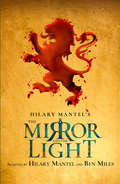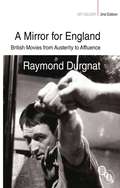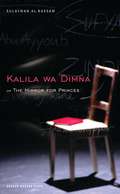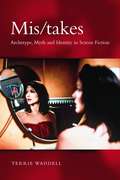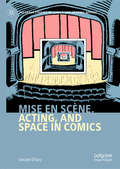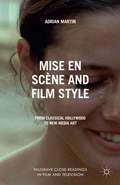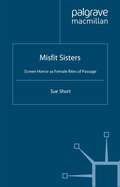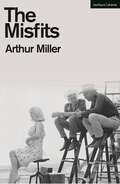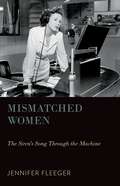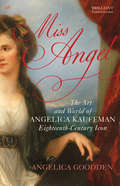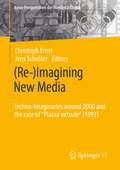- Table View
- List View
Mirror: The Film Companion (KINOfiles Film Companion)
by Natasha SynessiosAt the centre of Tarkovsky's oeuvre, _Mirror_ is his most complex and autobiographical film. It stretches the viewer by moving without apparent effort between past, present and imagined realities, in a series of episodes which observe neither plot nor overt logic. The film reconstructs and records iconic memories and deep emotional impressions in the life of an individual, a nation and an era. Audience reaction to 'Mirror' was overwhelming and it came to represent a watershed in many people's lives. It also occasioned Tartovsky's first open dialogue with his viewers, as letters poured in to convince him of the importance and need for his films. It remains to this day most Russians' favourite Tarkovsky film.
The Mirror and the Light: Rsc Stage Adaptation
by Hilary Mantel Ben MilesHilary Mantel and Ben Miles’ exhilerating stage adaptation of The Mirror and the Light, one of 2021’s must-see theatrical events, and the long awaited conclusion to the Oliver Award-winning Wolf Hall Trilogy.
The Mirror and the Palette: Rebellion, Revolution and Resilience: 500 Years of Women’s Self-Portraits
by Jennifer HiggieHer story weaves in and out of time and place. She's Frida Kahlo, Loïs Mailou Jones and Amrita Sher-Gil en route to Mexico City, Paris or Bombay. She's Suzanne Valadon and Gwen John, craving city lights, the sea and solitude; she's Artemisia Gentileschi striding through the streets of Naples and Paula Modersohn-Becker in Worpswede. She's haunting museums in her paint-stained dress, scrutinising how El Greco or Titian or Van Dyck or Cézanne solved the problems that she too is facing. She's railing against her corsets, her chaperones, her husband and her brothers; she's hammering on doors, dreaming in her bedroom, working day and night in her studio. Despite the immense hurdles that have been placed in her way, she sits at her easel, picks up a mirror and paints a self-portrait because, as a subject, she is always available. Until the twentieth century, art history was, in the main, written by white men who tended to write about other white men. The idea that women in the West have always made art was rarely cited as a possibility. Yet they have - and, of course, continue to do so - often against tremendous odds, from laws and religion to the pressures of family and public disapproval. In THE MIRROR AND THE PALETTE, Jennifer Higgie introduces us to a cross-section of women artists who embody the fact that there is more than one way to understand our planet, more than one way to live in it and more than one way to make art about it. Spanning 500 years, biography and cultural history intertwine in a narrative packed with tales of rebellion, adventure, revolution, travel and tragedy enacted by women who turned their back on convention and lived lives of great resilience, creativity and bravery. This is a dazzlingly original and ambitious book by one of the most well-respected art critics at work today.
A Mirror for England: British Movies from Austerity to Affluence (BFI Silver)
by Raymond DurgnatRaymond Durgnat's classic study of British films from the 1940s to the 1960s, first published in 1970, remains one of the most important books ever written on British cinema. In his introduction, Kevin Gough-Yates writes: 'Even now, it astounds by its courage and its audacity; if you think you have an 'original' approach to a filmor a director's work and check it against A Mirror for England, you generally discover that Raymond Durgnat had said it already.' Durgnat himself said about the book that 'the main point was arranging a kind of rendezvous between thinking about movies and thinking, not so much about sociology, as about the experiences that people are having all the time.'Durgnat used Mirror to assert the validity of British cinema against its dismissal by the critics of Cahiers du cinéma and Sight and Sound. His analysis takes in classics such as In Which We Serve (1942), A Matter of Life and Death (1946) and The Blue Lamp (1949), alongside 'B' films and popular genres such as Hammer horror. Durgnat makes a cogent and compelling case for the success of British films in reflecting British predicaments, moods and myths, at the same time as providing some disturbing new insights into a national character by whose enigmas and contradictions we continue to be perplexed and fascinated.
A Mirror for England: British Movies from Austerity to Affluence (BFI Silver)
by Raymond DurgnatRaymond Durgnat's classic study of British films from the 1940s to the 1960s, first published in 1970, remains one of the most important books ever written on British cinema. In his introduction, Kevin Gough-Yates writes: 'Even now, it astounds by its courage and its audacity; if you think you have an 'original' approach to a filmor a director's work and check it against A Mirror for England, you generally discover that Raymond Durgnat had said it already.' Durgnat himself said about the book that 'the main point was arranging a kind of rendezvous between thinking about movies and thinking, not so much about sociology, as about the experiences that people are having all the time.'Durgnat used Mirror to assert the validity of British cinema against its dismissal by the critics of Cahiers du cinéma and Sight and Sound. His analysis takes in classics such as In Which We Serve (1942), A Matter of Life and Death (1946) and The Blue Lamp (1949), alongside 'B' films and popular genres such as Hammer horror. Durgnat makes a cogent and compelling case for the success of British films in reflecting British predicaments, moods and myths, at the same time as providing some disturbing new insights into a national character by whose enigmas and contradictions we continue to be perplexed and fascinated.
The Mirror for Princes: Kalila wa Dimna (Oberon Modern Plays Ser.)
by Sulayman Al-BassamThis is a new writing based on the fables "Kalila wa Dimna", one of the masterpieces of Eastern culture. Intended originally as a book of Council for Kings, literally, a 'mirror' for princes, these subtle and philosophical animal fables carry immense significance to all sections of Arab and Persian society, until this day. From India, via Persia, the tales reached the Arab world through the pen of Ibn Al-Muqaffa, court scribe, wit, and radical reformer. The production locates Ibn Al-Muqaffa's work in its original historical context - Iraq circa 750 AD and the dawn of the Abbasid revolution - one of the most turbulent moments in Islamic history, and an age with all too many parallels to our own. Part history, part political fable, the drama explores the creation of these tales amidst the very real tragedy that unfolds around the author himself, as Al-Muqaffa battles for reform in the midst of fervent revolutionaries, heretic poets, religious propagandists, and a ruler who names himself none other than 'God's shadow on earth'."The Mirror for Princes" opened at the Barbican in May 2006, in a production by Sulayman Al-Bassam Theatre, an international group of theatre practitioners, musicians and visual artists, dedicated to the production of challenging and innovative theatre, led by Anglo-Kuwaiti writer and director Al-Bassam
A Mirror of Chaucer's World (PDF)
by Roger Sherman LoomisEach of the 179 pictures in this handsome book is accompanied by indications of source and date, and often by explanatory and reference material. The portrayals of Chaucer, his friends and associates, the poets he admired, and the places he knew, are drawn mainly from the period 1340 to 1415.Originally published in 1978.The Princeton Legacy Library uses the latest print-on-demand technology to again make available previously out-of-print books from the distinguished backlist of Princeton University Press. These editions preserve the original texts of these important books while presenting them in durable paperback and hardcover editions. The goal of the Princeton Legacy Library is to vastly increase access to the rich scholarly heritage found in the thousands of books published by Princeton University Press since its founding in 1905.
The Mirror of the Gods: Classical Mythology in Renaissance Art
by Malcolm BullPerhaps the single most revolutionary aspect of the Renaissance was the re-emergence of the gods and goddesses of antiquity. In the midst of Christian Europe, artists began to decorate luxury goods with scandalous stories from classical mythology, and rulers to identify themselves with the deities of ancient religion. The resulting fusion of erotic fantasy and political power changed the course of Western art and produced many of its most magical and subversive works.The first book ever to survey this extraordinary phenomenon in its entirety, The Mirror of the Gods takes the story from the Renaissance to the Baroque. Each chapter focuses on a particular god (Diana, Apollo, Hercules, Venus, Bacchus, Jupiter) and recounts the tales about that deity, not as they appear in classical literature but as they were re-created by artists such as Botticelli, Titian, Bernini and Rembrandt. And yet this is not a book simply about painting and sculpture. It is an attempt to re-imagine the entire designed world of the Renaissance, where the gods also appeared in carnival floats and in banquet displays, and entertained the public in the form of snow men and fireworks. This rich and original new portrait of the Renaissance will ensure that readers never see the period in quite the same way again.
Mirrorless Interchangeable Lens Camera: Getting the Most from Your MILC
by Steve AnchellMirrorless interchangeable lens cameras are changing the way images are captured, being far more in line with modern photography trends and sensibilities. With Mirrorless Interchangeable Lens Camera: Getting the Most from Your MILC, you’ll learn why this is happening and how to get the most from your mirrorless camera. This guide covers everything you need to know about the difference between a mirrorless camera and a DSLR, apps, lenses, video recording, and picture profiling features. You’ll learn how to use your mirrorless interchangeable lens camera for different genres of photography including landscape, travel, low light, street photography, portraiture, and more. Written by expert and skilled instructor Steve Anchell, this book includes 198 inspirational and instructional images with 154 in full-color, with insights and photographs from 9 professional photographers. It’s the perfect guide for established photographers not yet aware of the wealth of benefits mirrorless interchangeable lens cameras offer and for beginning photographers just starting their career.
Mirrorless Interchangeable Lens Camera: Getting the Most from Your MILC
by Steve AnchellMirrorless interchangeable lens cameras are changing the way images are captured, being far more in line with modern photography trends and sensibilities. With Mirrorless Interchangeable Lens Camera: Getting the Most from Your MILC, you’ll learn why this is happening and how to get the most from your mirrorless camera. This guide covers everything you need to know about the difference between a mirrorless camera and a DSLR, apps, lenses, video recording, and picture profiling features. You’ll learn how to use your mirrorless interchangeable lens camera for different genres of photography including landscape, travel, low light, street photography, portraiture, and more. Written by expert and skilled instructor Steve Anchell, this book includes 198 inspirational and instructional images with 154 in full-color, with insights and photographs from 9 professional photographers. It’s the perfect guide for established photographers not yet aware of the wealth of benefits mirrorless interchangeable lens cameras offer and for beginning photographers just starting their career.
Mis/takes: Archetype, Myth and Identity in Screen Fiction
by Terrie WaddellMis/takes departs from the bulk of screen discourse by applying Jungian and Post-Jungian ideas on unconscious processes to popular film and television. This perspective offers a rich insight into the way that various myths infiltrate popular culture. By examining the function of psychological motifs and symbols in cinema and television, Terrie Waddell opens up another way of thinking about how identity can be constructed and disrupted. Mulholland Drive, Memento, The Others, The X-Files, Twin Peaks, The Sopranos, Spider, Intimacy and Absolutely Fabulous all lend themselves to this approach. The close analysis of these films/programs are guided by a number of core archetypes from trickster and Self to incest and the grotesque. The book’s four parts reflect these dominant patterns: Jung, trickster and the screen Mistaken identities, self-deception and the undead Redeemers, bad dads and matricide Excesses of the sad and the sassy Mis/takes gives readers a chance to engage with screen material in an original and subversive way. This study will be of great interest to Jungian analysts and students of film, cultural studies, media, gender studies and analytical psychology.
Mis/takes: Archetype, Myth and Identity in Screen Fiction
by Terrie WaddellMis/takes departs from the bulk of screen discourse by applying Jungian and Post-Jungian ideas on unconscious processes to popular film and television. This perspective offers a rich insight into the way that various myths infiltrate popular culture. By examining the function of psychological motifs and symbols in cinema and television, Terrie Waddell opens up another way of thinking about how identity can be constructed and disrupted. Mulholland Drive, Memento, The Others, The X-Files, Twin Peaks, The Sopranos, Spider, Intimacy and Absolutely Fabulous all lend themselves to this approach. The close analysis of these films/programs are guided by a number of core archetypes from trickster and Self to incest and the grotesque. The book’s four parts reflect these dominant patterns: Jung, trickster and the screen Mistaken identities, self-deception and the undead Redeemers, bad dads and matricide Excesses of the sad and the sassy Mis/takes gives readers a chance to engage with screen material in an original and subversive way. This study will be of great interest to Jungian analysts and students of film, cultural studies, media, gender studies and analytical psychology.
Mise en scène, Acting, and Space in Comics (Palgrave Studies in Comics and Graphic Novels)
by Geraint D'ArcyThis book explores some of the less frequently questioned ideas which underpin comics creation and criticism. “Mise en scène” is a term which refers to the way in which visual elements work together to create meaning in comics. It is a term that comics have borrowed from cinema, which borrowed it in turn from theatre. But comics are not film and they are not cinema, so how can this term be of any use? If we consider comics to have mise en scène, should not we also ask if the characters in comics act like the characters on film and stage? In its exploration of these ideas, this book also asks what film and theatre can learn from comics.
Mise en Scène and Film Style: From Classical Hollywood to New Media Art (Palgrave Close Readings in Film and Television)
by A. MartinStyles of filmmaking have changed greatly from classical Hollywood through to our digital era. So, too, have the ways in which film critics and scholars have analysed these transformations in film style. This book explores two central style concepts, mise en scène and dispositif, to illuminate a wide range of film and new media examples.
Mise En Scene French Theatre Now (Plays and Playwrights)
by Annie Sparks Annie Stephenson David BradbyA invaluable survey of French theatre since 1968Mise en Scène is a book in two parts. The first half is a probing look at French theatre now, providing an historical and critical survey of drama and theatre in France since 1968. It explores playwrights such as Samuel Beckett, Marguerite Duras, Michel Vinaver and Bernard-Marie Koltès and directors of international reputation such as Peter Brook, Robert Wilson, Roger Planchon, Antoine Vitez, Patrice Chereau and Ariane Mnouchkine.The second part of Mise en Scène features a comprehensive listings guide to major theatre companies, insitutions, festivals, training schools and invaluable A-Z profiles of contemporary playwrights and directors from France.
Mise En Scene French Theatre Now (Plays and Playwrights)
by Annie Sparks Annie Stephenson David BradbyA invaluable survey of French theatre since 1968Mise en Scène is a book in two parts. The first half is a probing look at French theatre now, providing an historical and critical survey of drama and theatre in France since 1968. It explores playwrights such as Samuel Beckett, Marguerite Duras, Michel Vinaver and Bernard-Marie Koltès and directors of international reputation such as Peter Brook, Robert Wilson, Roger Planchon, Antoine Vitez, Patrice Chereau and Ariane Mnouchkine.The second part of Mise en Scène features a comprehensive listings guide to major theatre companies, insitutions, festivals, training schools and invaluable A-Z profiles of contemporary playwrights and directors from France.
Misfit Sisters: Screen Horror as Female Rites of Passage
by S. ShortThis timely study breaks new ground in exploring how recent film and television horror texts articulate a female rite of passage, updating the cautionary concerns found in fairy tales of the past, particularly in warning against predatory men, treacherous females and unhappy family situations.
The Misfits: The Misfits; After The Fall; Incident At Vichy; The Price; Creation Of The World; Playing For Time
by Arthur MillerDiscover the cinema-novelization of Arthur Miller's 1961 American western film, The Misfits, which was directed by John Huston and went on to be one of the most popular cult films of the 1960s.A story of four lost souls - the beautiful Roslyn who has never belonged to anyone or anything, and three other misfits who roam the open land existing on the little money made from riding in rodeos and rounding up wild horses - who meet in Reno to discover that freedom has its price, and the heart its rules.The Misfits starred Clark Gable, Marilyn Monroe and Montgomery Cliff. Based on a short story of the same name, originally published in 1957, this cinema novel of the film includes an introduction by Arthur Miller himself.
The Misfits
by Arthur MillerDiscover the cinema-novelization of Arthur Miller's 1961 American western film, The Misfits, which was directed by John Huston and went on to be one of the most popular cult films of the 1960s.A story of four lost souls - the beautiful Roslyn who has never belonged to anyone or anything, and three other misfits who roam the open land existing on the little money made from riding in rodeos and rounding up wild horses - who meet in Reno to discover that freedom has its price, and the heart its rules.The Misfits starred Clark Gable, Marilyn Monroe and Montgomery Cliff. Based on a short story of the same name, originally published in 1957, this cinema novel of the film includes an introduction by Arthur Miller himself.
Misfits & Hybrids: Architectural Artifacts for the 21st-Century City
by Ferda KolatanContemporary cities are shaped by the unlikely adjacencies of objects that are vastly different in kind, origin, and scale: buildings, infrastructure, and other urban components that over time accumulate into mismatched configurations. However, despite the ubiquity of these oddities and their impact on the city, we rarely give them much consideration. In Misfits & Hybrids, Ferda Kolatan explores the untapped potential in these unexpected conditions for a new kind of architecture. A diverse array of projects, developed in Kolatan’s design studios at the University of Pennsylvania Weitzman School of Design, illustrates how hybrid artifacts can reveal the often overlooked cultural, socio-political, and material histories of a site, fostering design tactics invested in reinventing the existing. Set within the cosmopolitan megacities of Istanbul, Cairo, and New York, the projects are conceived as real fictions, conjuring novel narrative, aesthetic, and representational forms to reflect the pluralistic postindustrial city.
Misfits & Hybrids: Architectural Artifacts for the 21st-Century City
by Ferda KolatanContemporary cities are shaped by the unlikely adjacencies of objects that are vastly different in kind, origin, and scale: buildings, infrastructure, and other urban components that over time accumulate into mismatched configurations. However, despite the ubiquity of these oddities and their impact on the city, we rarely give them much consideration. In Misfits & Hybrids, Ferda Kolatan explores the untapped potential in these unexpected conditions for a new kind of architecture. A diverse array of projects, developed in Kolatan’s design studios at the University of Pennsylvania Weitzman School of Design, illustrates how hybrid artifacts can reveal the often overlooked cultural, socio-political, and material histories of a site, fostering design tactics invested in reinventing the existing. Set within the cosmopolitan megacities of Istanbul, Cairo, and New York, the projects are conceived as real fictions, conjuring novel narrative, aesthetic, and representational forms to reflect the pluralistic postindustrial city.
Mismatched Women: The Siren's Song Through the Machine (Oxford Music / Media)
by Jennifer FleegerIn Mismatched Women, author Jennifer Fleeger introduces readers to a lineage of women whose voices do not "match" their bodies by conventional expectations, from George du Maurier's literary Trilby to Metropolitan Opera singer Marion Talley, from Snow White and Sleeping Beauty to Kate Smith and Deanna Durbin. The book tells a new story about female representation by theorizing a figure regularly dismissed as an aberration. The mismatched woman is a stumbling block for both sound and feminist theory, argues Fleeger, because she has been synchronized yet seems to have been put together incorrectly, as if her body could not possibly house the voice that the camera insists belongs to her. Fleeger broadens the traditionally cinematic context of feminist film theory to account for literary, animated, televisual, and virtual influences. This approach bridges gaps between disciplinary frameworks, showing that studies of literature, film, media, opera, and popular music pose common questions about authenticity, vocal and visual realism, circulation, and reproduction. The book analyzes the importance of the mismatched female voice in historical debates over the emergence of new media and unravels the complexity of female representation in moments of technological change.
Miss Angel: The Art and World of Angelica Kauffman, Eighteenth-Century Icon
by Angelica GooddenA word was coined to describe the condition of people stricken with a new kind of fever when the Swiss-born artist Angelica Kauffman (1741-1807) came to London in 1766. 'The whole world', it was said, 'is Angelicamad.' One of the most successful women artists in history - a painter who possessed what her friend Goethe called an 'unbelievable' and 'massive' talent - Kauffman became the toast of Georgian England, captivating society with her portraits, mythological scenes and decorative compositions. She knew and painted poets, novelists and playwrights, collaborating with them and illustrating their work; her designs adorned the houses of the Grand Tourists she had met and painted in Italy; actors, statesmen, philosophers, kings and queen sat to her; and she was the force that launched a thousand engravings. Despite rumours of relationships with other artists (including Sir Joshua Reynolds), and an apparently bigamous and annulled first marriage to a pseudo Count, Kauffman was adopted by royalty in England and abroad as a model of social and artistic decorum. A profoundly learned artist, but one who is loved, above all, for her tender adaptations from classical antiquity and sentimental literature; a commercially successful celebrity yet also a founding member of The Royal Academy of arts; the virginal creator of sexually ambivalent beings who was one of the hardest-headed businesswomen of her age, Kauffman's life and work is full of apparent contradictions explored in this first biography in over 80 years.
Miss Dior: A Story of Courage and Couture (from the acclaimed author of Coco Chanel)
by Justine Picardie'A gripping story in which Justine Picardie brilliantly contrasts the cruel Old World of wartime France with the hopeful New World epitomised by Christian Dior's New Look.'ANTONIA FRASER'Catherine's story is beautifully, hauntingly told in spare and elegant prose by Picardie . . . moving and evocative.'THE TIMES'Picardie's book is of the moment, celebrating an unsung hero at a time when female influences are earning new acclaim.'VOGUEMiss Dior is a story of freedom and fascism, beauty and betrayal, roses and repression, and how the polished surface of fashion conceals hidden depths. It paints a portrait of the enigmatic woman behind the designer Christian Dior: his beloved younger sister Catherine, who inspired his most famous perfume and shaped his vision of femininity. Justine Picardie's journey takes her to Occupied Paris, where Christian honed his couture skills while Catherine dedicated herself to the French Resistance, until she was captured by the Gestapo and deported to the German concentration camp of Ravensbrück.With unparalleled access to the Dior family homes and archives, Picardie's research into Catherine's courageous life shines a new light on Christian Dior's legendary work, and reveals how his enchanting 'New Look' emerged out of the shadows of his sister's suffering.Tracing the wartime paths of the Dior siblings leads Picardie deep into other hidden histories, and different forms of resistance and sisterhood. She explores what it means to believe in beauty and hope, despite our knowledge of darkness and despair, and discovers the timeless solace of the natural world in the aftermath of devastation and destruction. The result is an exquisite and unforgettably moving book.*A beautiful, full colour illustrated book featuring exclusive images from the Dior archives*
**Missing**: Techno-Imaginaries around 2000 and the case of "Piazza virtuale" (1992) (Neue Perspektiven der Medienästhetik)
by Christoph Ernst Jens SchröterThe late 20th century was a formative phase in the history of digital media culture. The introduction of "new media" was associated with promises for the future that still resonate today. This book brings together contributions that discuss key aspects of the "imaginaries" surrounding new media in this epoch. The focus is on the works of the media artist group Van Gogh-TV, especially the historically very important interactive television project "Piazza virtuale" (1992).

